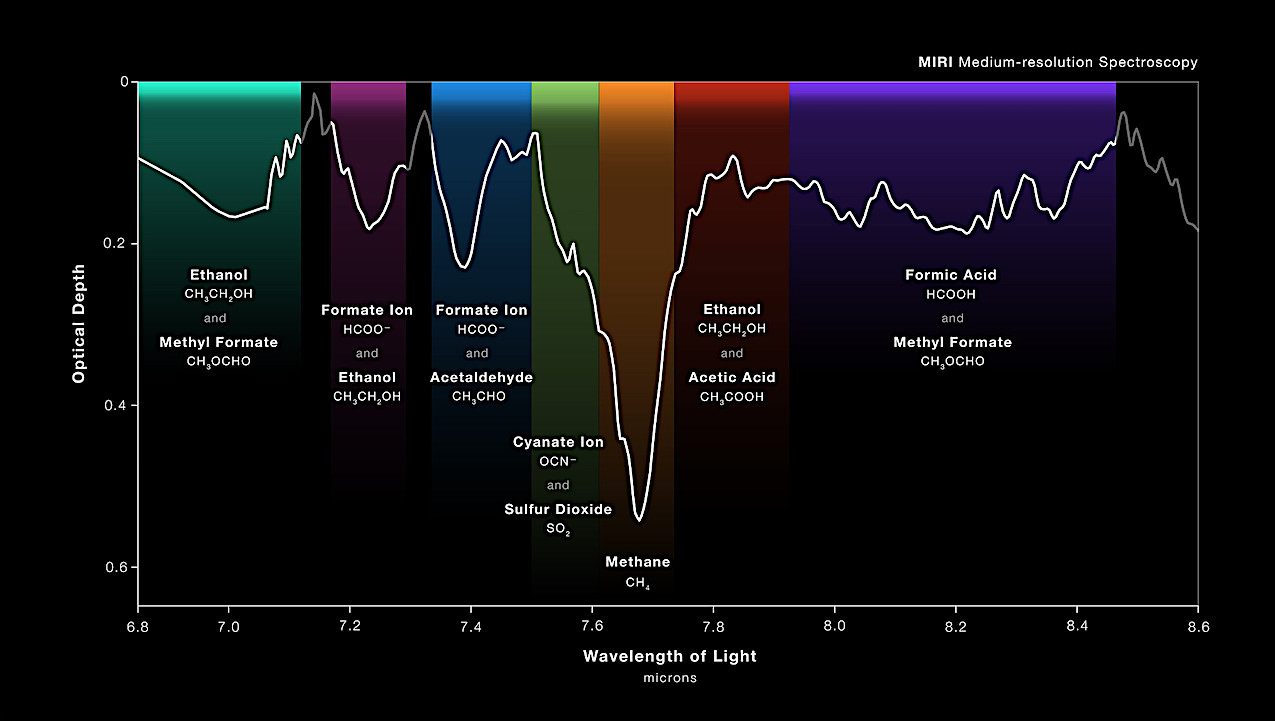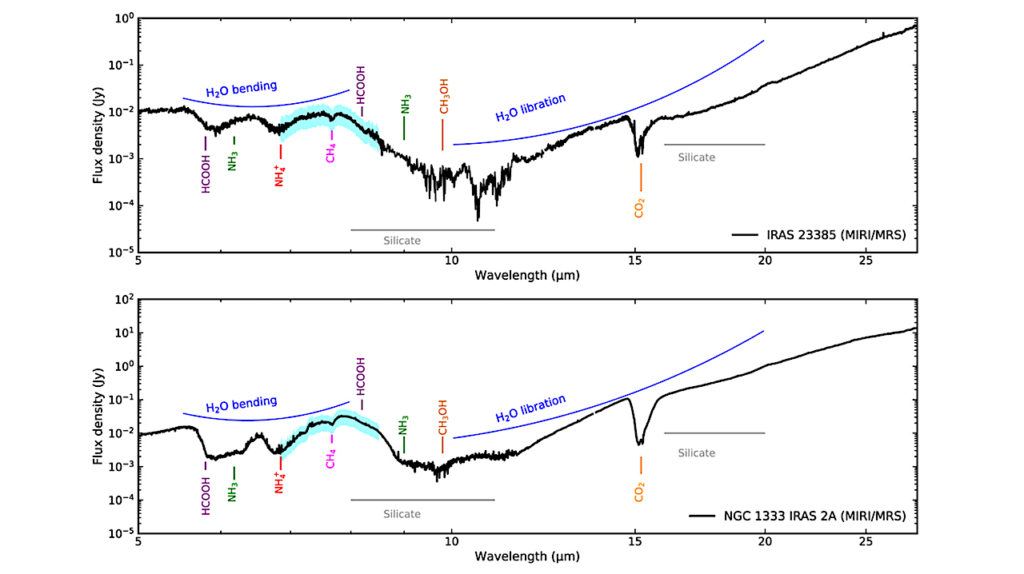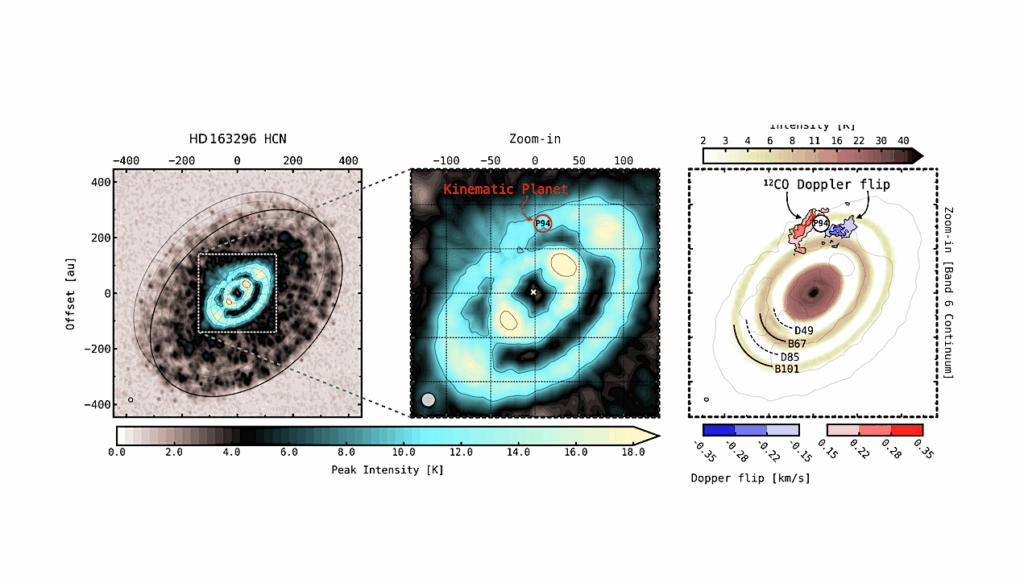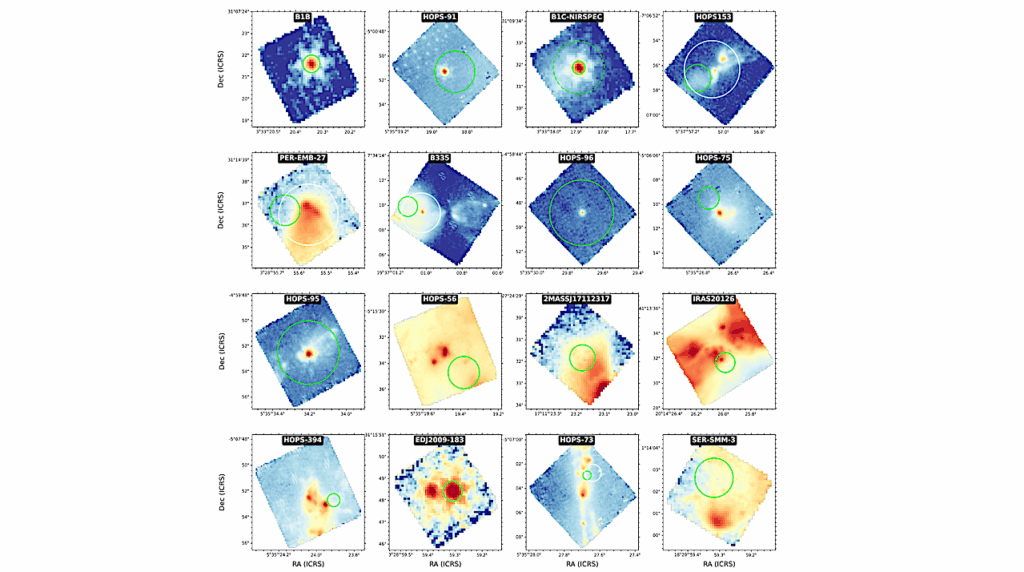Webb Telescope Finds A Wide Variety of Organic Molecules Surrounding Early-stage Protostars

An international team of astronomers using the NASA/ESA/CSA James Webb Space Telescope have discovered a variety of molecules, ranging from relatively simple ones like methane to complex compounds like acetic acid and ethanol, in early-stage protostars where planets have not yet formed. These are key ingredients for making potentially habitable worlds.
The presence of complex organic molecules (COMs) [1] in the solid phase in protostars was first predicted decades ago from laboratory experiments, and tentative detections of these molecules have been made by other space telescopes. This includes Webb’s Early Release Science Ice Age programme, which discovered diverse ices in the darkest, coldest regions of a molecular cloud measured to date.
Now, with the unprecedented spectral resolution and sensitivity of Webb’s Mid-InfraRed Instrument (MIRI), as part of the JOYS+ (James Webb Observations of Young ProtoStars) programme, these COMs have been individually identified and confirmed to be present in the interstellar ices. This includes the robust detection of acetaldehyde, ethanol (what we call alcohol), methyl formate, and likely acetic acid (the acid in vinegar), in the solid phase.
“This finding contributes to one of the long-standing questions in astrochemistry,” said team leader Will Rocha of Leiden University in the Netherlands. “What is the origin of COMs in space? Are they made in the gas phase or in ices? The detection of COMs in ices suggests that solid-phase chemical reactions on the surfaces of cold dust grains can build complex kinds of molecules.”

MIRI MRS spectrum of the high-mass protostar IRAS 23385+6053 (top) and the low-mass protostar NGC 1333 IRAS 2A (bottom). Strong gas-phase emission lines are masked in both spectra. The assignments for the absorption bands are given and differentiated by the colours. The shaded cyan area indicates the “COMs region” that is studied in this work. — Astronomy and Astrophysics
As several COMs, including those detected in the solid phase in this research, were previously detected in the warm gas phase, it is now believed that they originate from the sublimation of ices. Sublimation is to change directly from a solid to a gas without becoming a liquid. Therefore, detecting COMs in ices makes astronomers hopeful about developing an improved understanding of the origins of other even larger molecules in space.
Harold Linnartz [2] led the Laboratory for Astrophysics in Leiden over many years and coordinated the measurements of the data used in this study. Ewine van Dishoeck of Leiden University, one of the coordinators of the JOYS+ programme, shared, “Harold was particularly happy that in the COM assignments lab work could play an important role as it has been a long time getting here.”
Scientists are also keen to explore to what extent these COMs are transported to planets at much later stages in the evolution of the protostar. COMs in ices are transported more efficiently into planet-forming discs than gas from clouds. These icy COMs can therefore be inherited by comets and asteroids which in turn may collide with planets in formation. In that scenario COMs can be delivered to those planets, potentially providing the ingredients for life to flourish.
The science team also detected simpler molecules, including methane, formic acid (which makes the sting of ants painful), sulphur dioxide, and formaldehyde. Sulphur dioxide in particular allows the team to investigate the sulphur budget available in protostars. In addition, it is of prebiotic interest because existing research suggests that sulphur-containing compounds played an important role in driving metabolic reactions on the primitive Earth. Negative ions were also detected [3]; they form part of salts that are crucial for developing further chemical complexity at higher temperatures. This indicates that the ices may be much more complex and require further research.
Of particular interest is that one of the sources investigated, IRAS 2A, is characterised as a low-mass protostar. IRAS 2A may therefore have similarities with the primordial stages of our own Solar System. If that is the case, the chemical species identified in this protostar may have been present in the first stages of development of our Solar System and were later delivered to the primitive Earth.
All of these molecules can become part of comets and asteroids and eventually new planetary systems when the icy material is transported inward to the planet-forming discs as the protostellar system evolves,” said van Dishoeck. “We look forward to following this astrochemical trail step by step with more Webb data in the coming years.”
Other recent work by Pooneh Nazari of Leiden Observatory also raises astronomers’ hopes for finding more complexity in ices, following the tentative detections of methyl cyanide and ethyl cyanide from Webb NIRSpec data. Nazari says, “It is impressive how Webb now allows us to further probe the ice chemistry down to the level of cyanides, important ingredients in prebiotic chemistry.”
Notes
[1] A molecule is a particle made up of two or more atoms that are held together by chemical bonds. A complex organic molecule is a molecule with multiple carbon atoms.
[2] These results are dedicated to team member Professor Harold Linnartz, who unexpectedly passed away in December 2023, shortly after the acceptance of this paper. Linnartz made significant contributions to the study of gaseous and icy molecules in space. He was the Director of the Leiden Laboratory for Astrophysics and many of the ice-phase spectra of simple and complex molecules used in this research were collected by students under his supervision. Linnartz was thrilled with the quality of the Webb data and the significance of these results for astrochemistry.
[3] An ion is an atom or molecule that has an overall electrical charge, resulting from an excess or deficit in the number of negative electrons compared to the number of positive protons in the ion. A negative ion is an ion with a net negative charge (so a surplus of electrons).
More information
These observations were taken as part of the JOYS+ (James Webb Observations of Young ProtoStars) programme, coordinated by Ewine van Dishoeck of Leiden University in the Netherlands, and Michael Ressler of NASA’s Jet Propulsion Laboratory. The research was led by Will Rocha Leiden University. The cyanate studies were made as part of the IPA (Investigating Protostellar Accretion) programme, coordinated by Tom Megeath of the University of Toledo.
Webb is the largest, most powerful telescope ever launched into space. Under an international collaboration agreement, ESA provided the telescope’s launch service, using the Ariane 5 launch vehicle. Working with partners, ESA was responsible for the development and qualification of Ariane 5 adaptations for the Webb mission and for the procurement of the launch service by Arianespace. ESA also provided the workhorse spectrograph NIRSpec and 50% of the mid-infrared instrument MIRI, which was designed and built by a consortium of nationally funded European Institutes (The MIRI European Consortium) in partnership with JPL and the University of Arizona.
Webb is an international partnership between NASA, ESA and the Canadian Space Agency (CSA).
Image Credit: ESA/Webb, NASA, CSA, W. Rocha et al.
JWST Observations of Young protoStars (JOYS+): Detecting icy complex organic molecules and ions, Astronomy and Astrophysics (open access)
Astrobiology, Astrochemistry, Astronomy,








